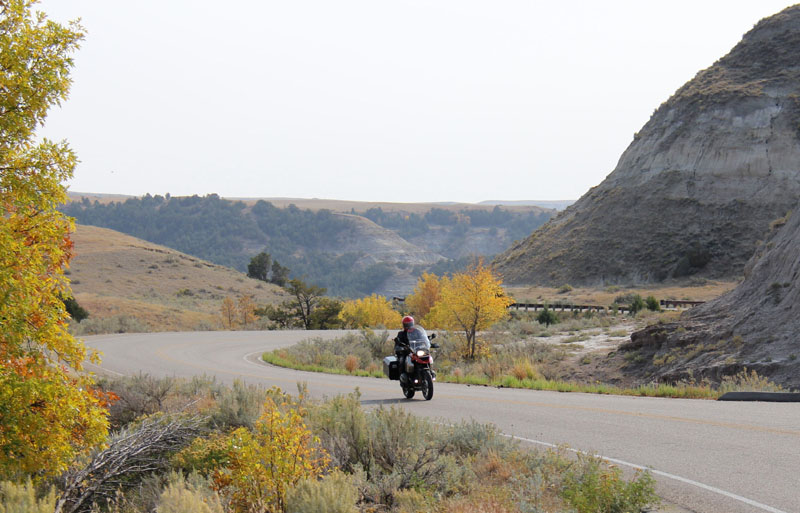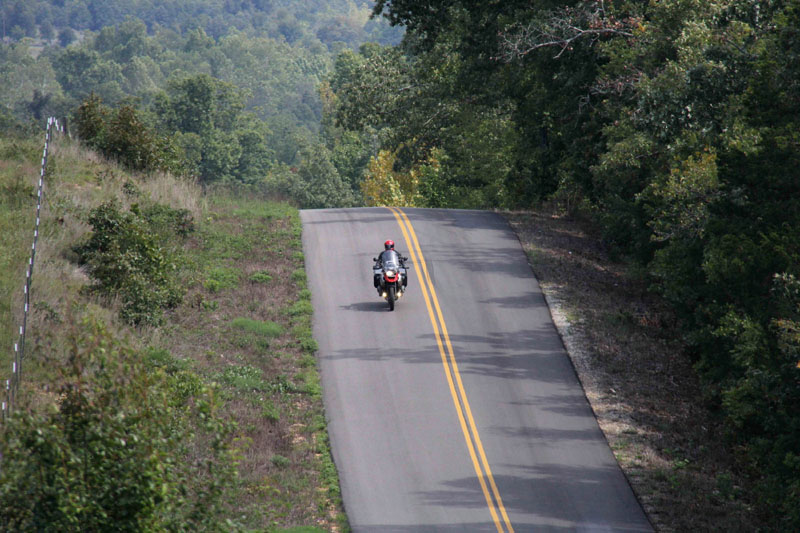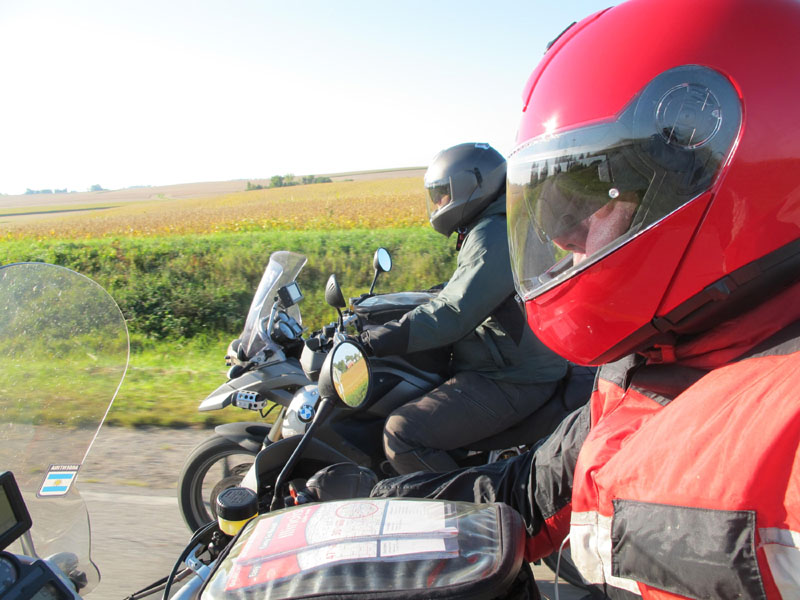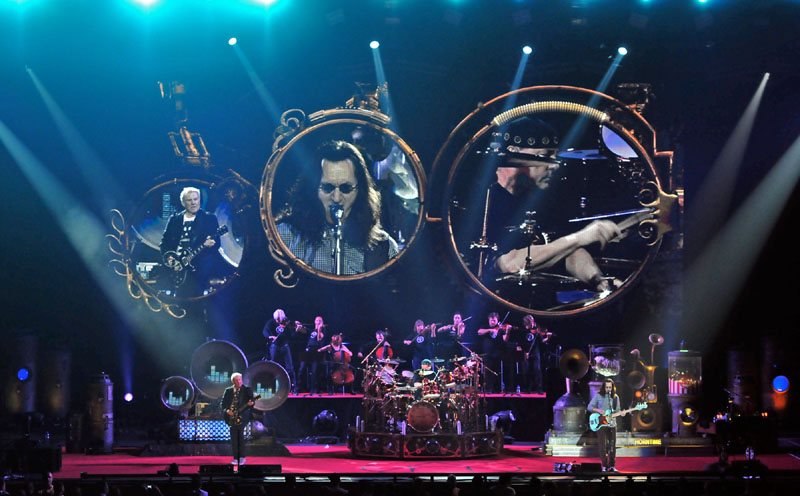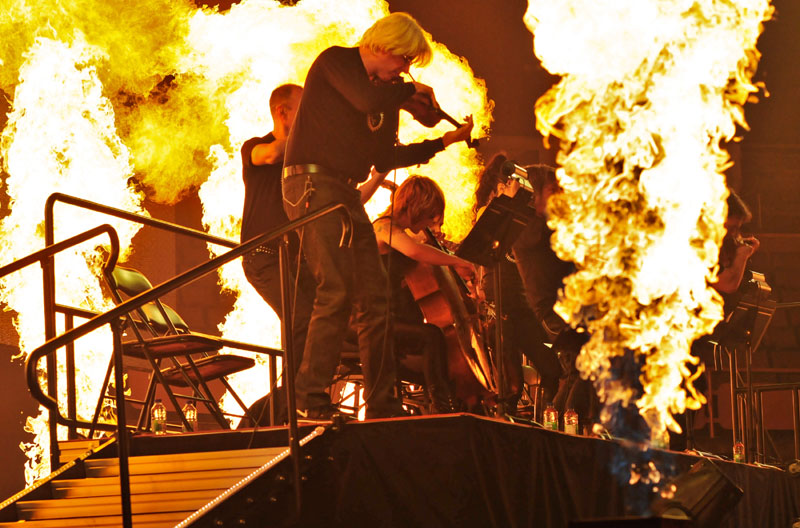Neil Peart's News, Weather and Sports
Where Words Fail, Music Speaks
NeilPeart.net, October 11, 2012
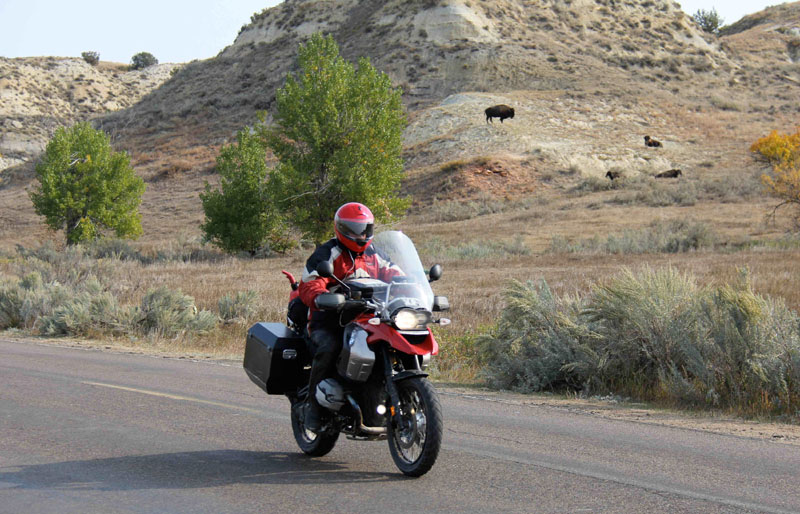 |
Deep in West Dakota |
This classic archetype of the American West - lone rider traversing badlands, bison, cottonwoods, and sage - was captured in Theodore Roosevelt National Park, in Western North Dakota, early on the morning of Tuesday, September 25, 2012.
The notion of "West Dakota" has humorous resonance for frequent co-adventurer Brutus and me. In our collaborative building of Bubba's Bar 'n' Grill, the cooking department on this site, we wanted a quirky name for the location of Brutus's branch of Bubba's test kitchens. We combined a disparaging nickname for his hometown of Calgary and an invented Western state to create "Cowfart, West Dakota."
Later we actually received a few grumbling messages from people demanding to know the exact location of Bubba's Bar 'n' Grill, so they could visit it. Given the place's "virtuality," the only possible answer is that Bubba's Bar 'n' Grill is everywhere. (Which perhaps explains the person who wrote to thank us for a great time there.) At least one couple wanted to be married at Bubba's, and another frustrated seeker claimed, "I found West Dakota, but I can't find Cowfart." To which the only possible response is, "?"
This particular morning began for me and my American riding partner Michael in a cold, sunny Walmart parking lot in Bismarck, North Dakota. On show nights we sleep on the bus while driver Dave delivers us to my chosen drop-off point, and in these days of budget-shuttered rest areas and crowded truck stops, he often parks us at a Walmart. (Their company policy welcomes RVs and travel trailers - overnight guests are potential morning customers.) After the previous night's show in Minneapolis, we had a day off before the next one in Winnipeg.
Among my duties on a show-day afternoon is planning our rides for the next couple of days. The relevant paper maps are spread around me on the floor of the bus's front lounge, and after a period of high-concept scanning, I highlight a meandering route along the smallest roads, and through the tiniest dots of communities (preferably of the one-Stop-sign variety). Hunched at his computer station in the corner, likewise on the floor, Michael transfers that route to the GPS program, "Mother," then to our onboard units, Doofus and Dingus. Early the following morning, after breakfast on the bus, we roll the bikes off the trailer and load up our supplies for the overnight journey. Finally pulling away and raising my feet to the pegs always combines a feeling of relief at having the morning's pre-travel chores done at last, and anticipation for the coming ride. The maps displayed on the bike-mounted Doofus and Dingus guide us more-or-less unerringly along an intricate chain of tiny backroads and secondary highways.
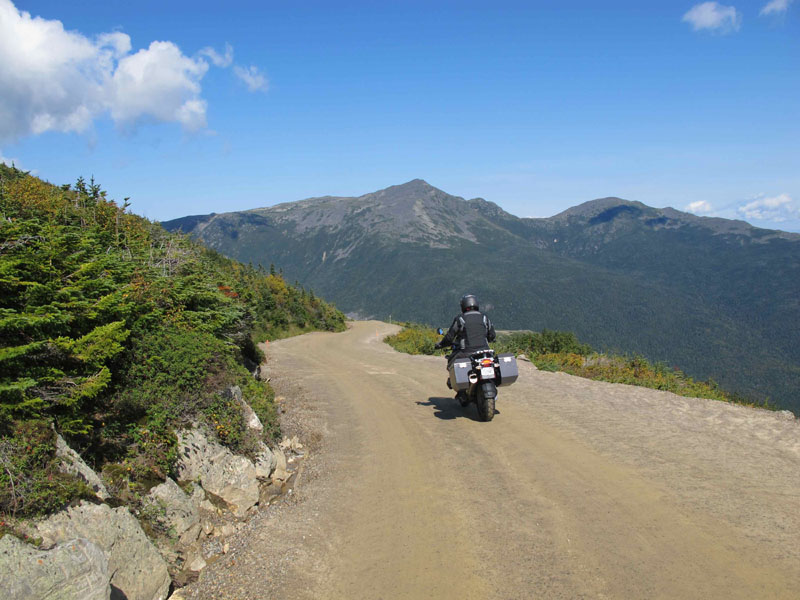 |
First show day, Mount Washington Auto Road, New Hampshire |
More than ever I celebrate a revelation that became apparent to me a few years ago:
"The best roads are the ones no one travels unless they live on them."
(Holding apart another rare category - roads that no one even lives on.)
Because our travels this tour began in the heavily populated East (more about the actual shows later - some people have the crazy notion that these tours are about something more than the motorcycle rides between), designing routes like that could be a challenge. As an example, consider just the first puzzle: getting from the opening show in Manchester, New Hampshire, to the second in the D.C. area.
As a rule, after the shows I try to "stage" the bus somewhere along the direct interstate route to the next city, for Dave's sake - it's no fun navigating a forty-five-foot bus and a twenty-foot trailer along roads no one travels unless they live on them. Because I sleep much better when the bus is stationary, I usually try to keep those drives to two or three hours. (I have remarked before how pleasant it is to feel the bus being maneuvered into a parking spot, and the main engine shudder and die into the steady drone of the generator. Now my bed is not going to move anymore.)
Before the Manchester show, I sat on the bus floor and spread out the maps of the intervening states - New York, Pennsylvania, Maryland, West Virginia, and Virginia. With much furrowing of brow, I tried to string together enough of the little roads and small towns to make an enjoyable two-day ride.
However, it was a real head-strainer. Whichever way I looked, so many cities and densely populated areas blocked the way, with interstates the only through routes. As a card-carrying shunpiker, I conscientiously avoid major roads except into and out of major cities. Especially on days off, I make every effort not to travel even one mile on a four-lane road. But in this impossible situation, I finally settled on a "hybrid" route - choosing some more desirable areas, and connecting them by a couple of interstate links. Thus I would use the big roads for their intended purpose - as mileage-disposal units, and relatively speedy ways through or around cities.
Next morning, from a Walmart parking lot in Newburgh, New York, Michael and I unloaded and packed the bikes. We followed sweet little roads through the Delaware Water Gap area of New Jersey, quiet and densely forested, across a tiny toll bridge over the Delaware to the Pennsylvania side. (Right around there I once saw a black bear cub.) We had another remarkably long stretch of serene riding, narrow roads winding through woods and around small lakes dotted with rustic cabins.
Then, at the strategic point where things were about to get congested, we jumped on the superslab - just in time for a monsoon rainstorm. In heavy rain, I would much rather be on a backroad, because the trucks on the interstate throw up such a cloud of spray that you can't even see the road's surface.
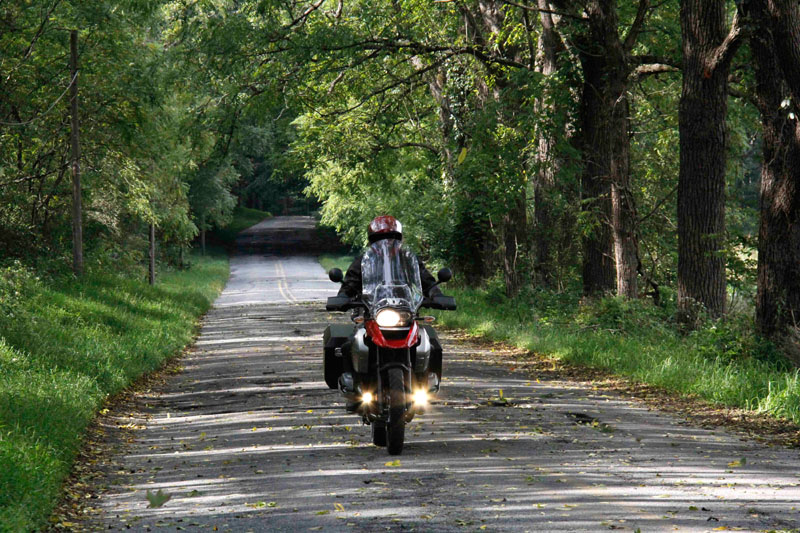 |
From the "Cliché Busters" series - New Jersey |
To a motorcycle rider, nothing is more important than the road's surface.
But, it was what it was, so we slowed down and kept things smooth and careful.
On the other side of that urban and suburban nexus of Harrisburg-Reading, we made our escape to the little roads again, down through Southern Pennsylvania into Maryland.
Among many changes leading into this tour, onstage and off (patient reader, in the fullness of time, I will try to address them all), Michael decided to get serious about photography. Even in principle, I was all for that - he would be taking better pictures of me!
He bought a professional-grade SLR body with a big fancy lens, and got some instruction from a knowledgable friend on how to use it. On our earliest rides, even his first experiments demonstrated the remarkable difference in what he could capture compared to my little hand-held model. We could pick a scenic backdrop and set up a shot, and I would do a couple of passes for Michael while he fired off a machine-gun-like series of images. (He called it the "spray and pray" approach.)
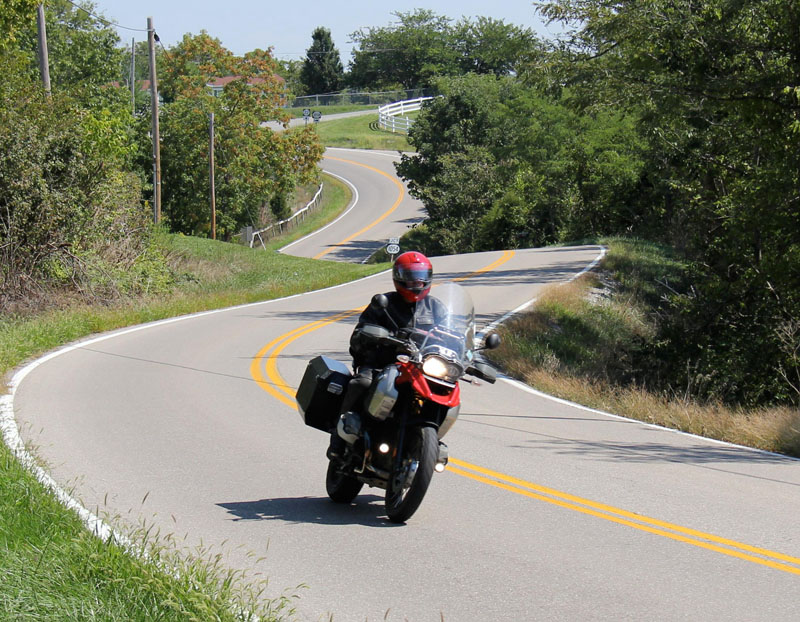
At least one of them was bound to be good - and they were. But now I had a new job every show day - editing the dozens of photographs that Michael would download and pass over to me. That job added another hour's work to that always-busy time, and choosing from all the "sprays" was sometimes as head-breaking as the mapping - but the rewards of both should be clear in this story.
Getting back to the route-mapping, other early rides this time didn't require such desperate measures. For example, we had a couple of days of absolutely sublime riding in West Virginia - all in all, after long and careful evaluation, the best motorcycling in the East. The state weaves a wonderful variety of twisty paved roads, usually lightly traveled, and among its leafy mountains, it also hides the largest number of what I have come to consider a kind of shunpiker's holy grail, for their rarity and pleasure - one-lane paved roads. We also try to toss in some off-pavement riding every day when we can, and in that category, West Virginia never fails to throw some adventure back at us.
(Speaking of those leafy mountains, I couldn't help thinking of the strip mines, clear-cuts, and chemical plants that also scar West Virginia, and noted, "So much beauty hiding so much ugliness.")
This time, just before we were about to start a long unpaved section, we paused for a minute at the roadside. A pickup truck stopped beside us, and the driver said, "Do you fellas know where you're going?"
I said I thought we did, and walked over with my paper map. I showed him the dotted line that led between a nearby town, Webster Springs, toward another dot called Pickens. He shook his head, puzzled, and said, "I don't know what that road might be, and I've lived here all my life."
He pointed up the way we were going, "This road is gated - you can't get through."
However, in the course of a leisurely, West-Virginia-style conversation, it turned out that our man worked for a logging company that controlled about 360,000 acres in the area, and his boss planned an inspection of this particular section soon. Our man was just about to drive up and unlock the two gates, and he invited us to follow him through.
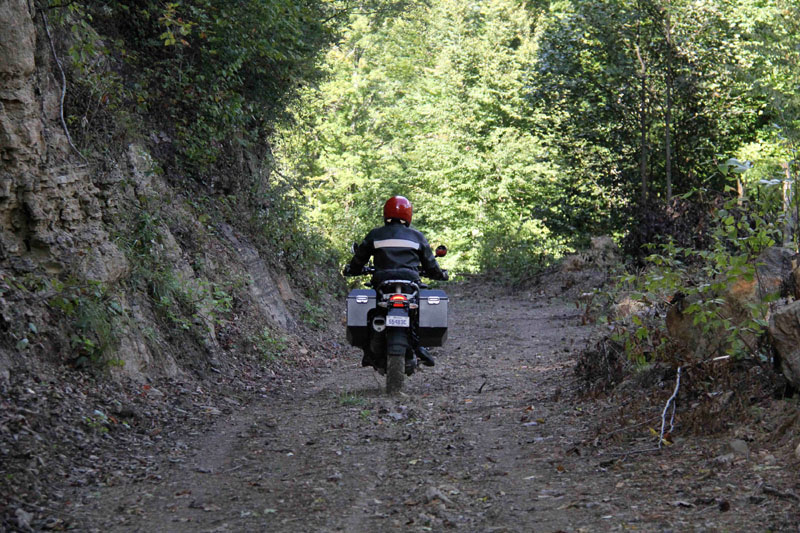
Now here was a road that took shunpiking all the way: no one lived on it, no one traveled it, and no one was even allowed on it.
After a long stretch of linked gravel trails and tracks, often running along high ridges on logging roads at around 3,000 feet - high for the East - we emerged at the time-capsule community of Pickens with a kind of Twilight Zone feeling. Deep in the heart of West Virginia, Pickens (population 66) might be the most remote settlement in the East. It certainly felt that way to us, emerging from gravel roads through deep woods to see its quaint little post office, freshly painted railroad depot (though the tracks were long gone), and a couple of hand-carved wooden signs, one reading "School" and the other "Leper Grave." (Whoa!)
This "attraction" evokes some curious history and a local hero, Dr. James Cunningham (1863-1965), who practiced in Pickens for over sixty years. He delivered 3,600 babies without losing a mother, and treated one of West Virginia's three known cases of leprosy. A Syrian railroad worker named Rashid was exiled by company officials to Pickens - even then, "the most remote terminal on the line" - where he died soon after.
On the day of my sixtieth birthday, September 12 (Yay! I'm a sexagenarian!), I was able to plot 332 miles from a Walmart in Columbus down through Southwestern Ohio, across Northern Kentucky, then up through Southeastern Indiana to Bloomington.
In all that seven hours of riding, most of it as good as it gets, we did not experience one minute of congestion. Think about that for a moment - a whole day of moving through the world at a velocity determined solely by your own energy and whims. Just winding little roads, rural countryside, crossroads towns, and glorious weather and scenery.
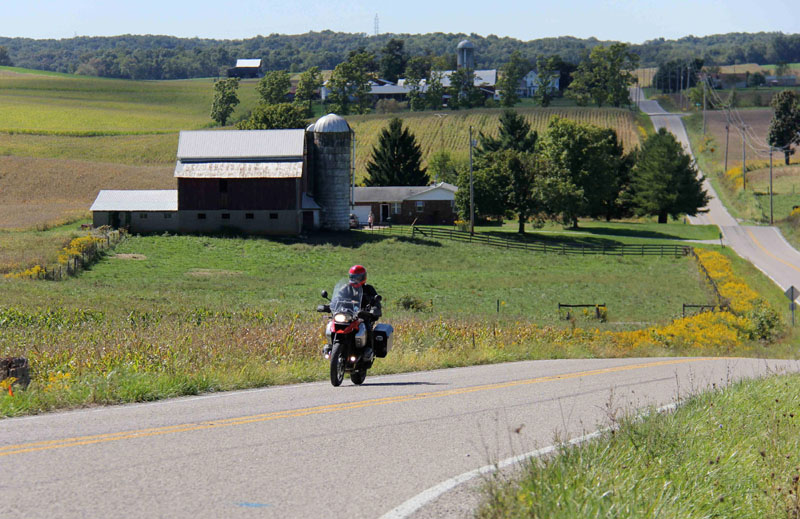 |
Southeastern Ohio |
"Roads no one travels unless they live on them."
It was a fine birthday present.
As often seems to happen in my seemingly random explorations of rural America, those early rides also introduced some unexpected themes that would echo in other days. At the bottom of the Mount Washington Auto Road, on the day of the first show in Manchester, we noticed an encampment of primitive-looking canvas tents, open fires, and people wandering around in costumes from centuries past. My first thought was "Civil War re-enactment," which I knew to be a popular hobby for some Americans, but Michael pointed out that we were too far north for that war. The tricorn hats worn by some of the campers were another clue - they were Revolutionary War re-enactors. Who knew?
But it was the Civil War that haunted our travels for the next few days. In Pennsylvania, we passed Gettysburg, where President Lincoln's famous "Four score and seven years ago" address was delivered after a terrible battle, then south to Maryland and past Antietam - the site of one of the deadliest single battles in American history, leaving 23,000 casualties, and over 3,600 dead. Such slaughter is sad to contemplate.
In exploring for hotels in that region, I wanted to stay at the nearby State Line Motel, on Mason-Dixon Road (named after the eighteenth-century surveyors who drew a symbolic line between the North and South) - just for the name and place, really. But once we arrived for a look-over, the property appeared neglected.
After years of surveying motels in smaller towns and deciding "yea" or "nay" by purely visual, external clues, lately, for my ongoing study of "Roadcraft" (subtitled "How to Work the World," the ultimate metaphor of travel and life, and a lifetime project), I have been trying to define the details that give me the feeling that a place just isn't being cared for. The paint, for one, and the landscaping, but perhaps the best indicator of neglect is weeds and grass growing up through the asphalt. That may well represent the care given to other aspects of the property. Like the sheets and towels. In any case, the restaurant beside the State Line Motel was closed, a deal-breaker for us. Onward to the Best Western in Hagerstown, Maryland, and a gigantic buffet, full of gigantic people, with a wine list offering a choice of soda pops.
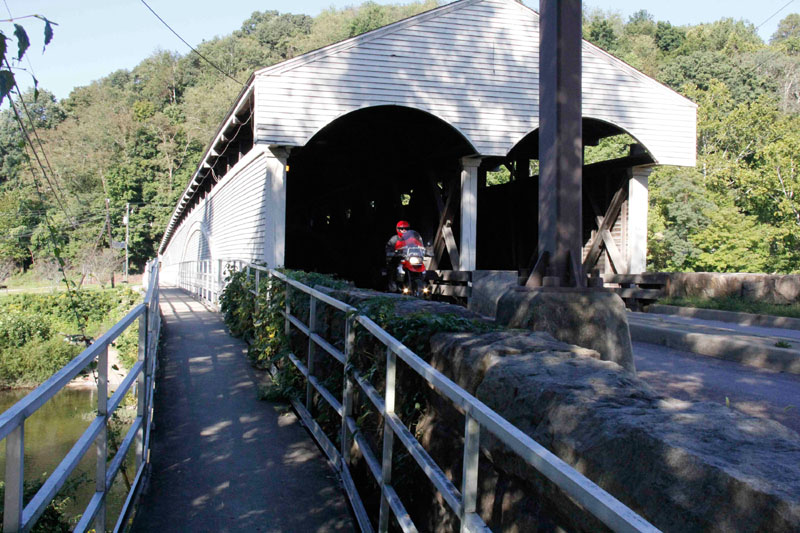
The next show's venue was near Manassas, Virginia, where two horrific battles were fought near the creek called Bull Run. In Philippi, West Virginia, a sign announced the town as the site of "the first land battle of the Civil War." Beside what must be a uniquely large covered bridge, a sign described its use by both Union and Confederate armies.
On a previous tour we had ridden right beside the courthouse at Appomattox, where the surrender documents were signed by Generals Ulysses S. Grant and Robert E. Lee. Driver Dave, an American history enthusiast, always left a selection of his magazines by my bedside, often about cowboys and the Old West, and among them this time was a U.S. News & World Report special edition on the Civil War. The stories and pictures came alive as I traveled among the places where those events had happened so long ago.
That war, and others like it, were also forward in my thoughts because of the book I was reading early in this run: The Better Angels of Our Nature: Why Violence Has Declined, by Steven Pinker. (In a nice coincidence, the title is a quote from Abraham Lincoln.) A Canadian-born cognitive scientist and professor of psychology at Harvard, Steven Pinker is one of those rare and precious academics who is able to convey his deep knowledge and extensive research in a form that is both understandable and thought-provoking to what is called in publishing "the general reader." I definitely consider myself a general reader, in that sense, and had much appreciated an earlier book of his, How the Mind Works (1997), a Pulitzer Prize finalist, and reviews of The Better Angels of Our Nature had seemed intriguing.
On the morning of the first show, I carried that weighty volume with me for a stroll down the main street of Littleton, New Hampshire, from the quintessential motel to the quintessential diner, delightfully named Topic of the Town. These were both small-town pleasures I had discovered and written about on our last tour, while a new discovery in Littleton was Bishop's ice cream. Riding in the previous afternoon, I was tempted by its location in an old house on the edge of town (later Michael observed that in a town like Littleton, every business from plumbers to doctors to banks seemed to be in an old house). I had a wonderful blueberry milkshake, which was locally called a "frappe," I learned when I asked the owner why I didn't see milkshakes listed on his menu board.
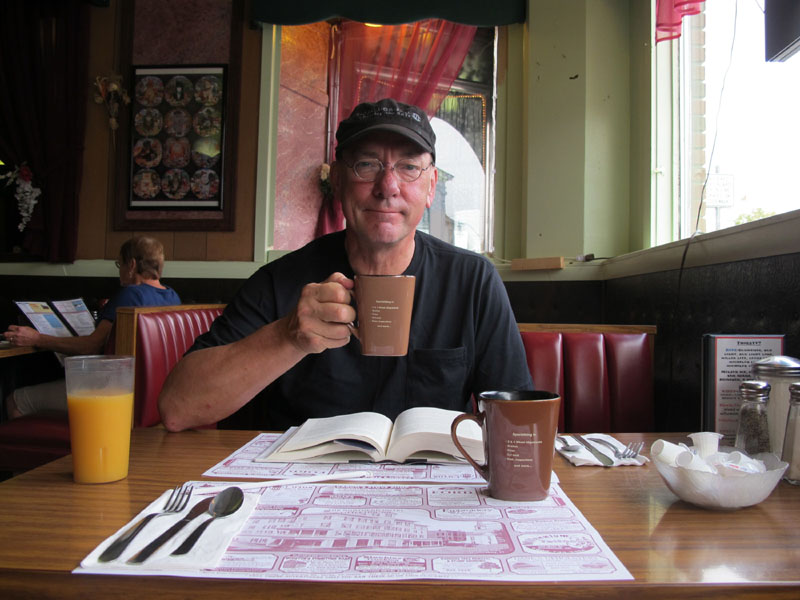
At the Topic of the Town, over my orange juice and coffee, I waited for my oatmeal and eggs, recreated a self-portrait from that previous visit, then started reading ...
One of these days I will push aside the cobwebs over at Bubba's Book Club and write up the growing list of great titles I have read in the past year or so. (Before the tour, in the last of my "free time," I was carrying around a box full of about fifteen books that I wanted to start writing about - but it was not to be.) A full report on this book will surely find its way onto that list.
Meanwhile, here is a quote from the review that piqued my interest, by Peter Singer in the New York Times. "[It] is a supremely important book. To have command of so much research, spread across so many different fields, is a masterly achievement. Pinker convincingly demonstrates that there has been a dramatic decline in violence, and he is persuasive about the causes of that decline."
I will have more to say about the reflections the book inspired during my travels around the Eastern United States, as Steven Pinker's revelations and reflections evoked and clarified some of my own.
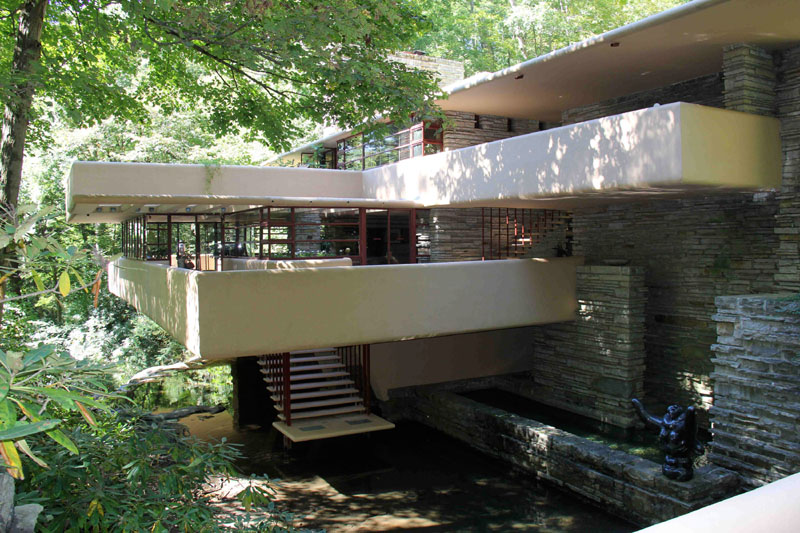 |
Falling Water |
Another semi-related theme emerged on the way to a show in Pittsburgh, when I routed us up from West Virginia through Maryland and onto a Pennsylvania backroad I had traveled with Brutus back on the first concert tour I did by motorcycle, Test for Echo, in 1996. That time, only by chance did we ride near a settlement named Bear Run, where I saw a sign for an attraction called Fallingwater. I recognized the name of a legendary masterpiece by revered architect Frank Lloyd Wright. Quickly computing that we had time for a visit, Brutus and I strolled down the path through the woods to encounter this exquisite structure set directly over a stream, just above a waterfall. Then and now, it was breathtaking and unforgettable to see. A home not only in its place, but of its place, and surely an expression of our better angels.
Allowing this narrative to spin out according to theme rather than chronology, about ten days later I was on the bus floor with my maps trying to plot an interesting route between St. Louis and Minneapolis. The obvious way would have been up through Wisconsin, with fine little roads for motorcycling among its humped green farmland. But it would be a Sunday, when every other two-wheeler in the state would be clogging the roads and little towns. (Michael once made me laugh by referring to summer Sundays in the Midwest as "Trike Day," but perhaps that's too esoteric an observation for the "general reader.")
On a Wisconsin Sunday in good weather, you were likely to come up behind long "processions" of cruisers doing what they do - cruising - but in tremendous numbers of staggered pairs, and very slowly. They actually get huffy if you try to pass your way through them, growling over as you try to cut in, "Don't break up our procession!" (Really.)
So, Wisconsin on a Tuesday? Absolutely.
On a sunny Sunday, not so much.
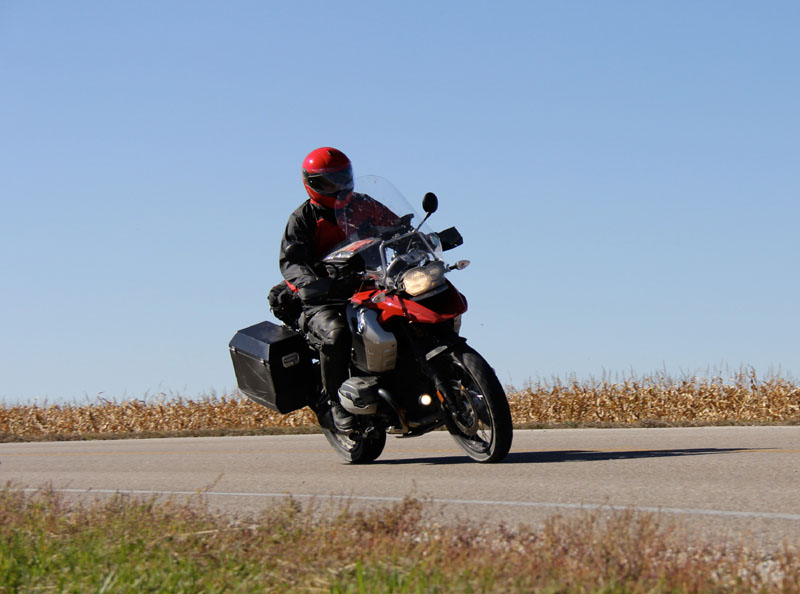 |
Banking Through Iowa (Cliché Busters 2) |
So, I thought, "Go West, old man," and pulled out the map of Iowa. I had chosen a similar diversion on our way from Indianapolis to Chicago, and on a previous tour, Iowa City had been a pleasant discovery - a small city enlivened by its university, the proverbial "college town." Both times we traced some lovely country roads through Western Illinois and Southern Iowa, paved and gravel, cornfields on one side and soybeans on the other (don't know why, but it always seemed to be that way), up to Iowa City. Despite its population of only about 67,000 people, the vitality and sociability of the students combines with the worldliness of the faculty members to create a vibrant energy. It was the kind of place where we could stay in a sophisticated boutique hotel, and stroll down a pedestrian-only street offering plenty of choices for eclectic dining - a rare combination in America's smaller communities. Other college towns, like Bloomington, Indiana, also shine that way.
The Wikipedia entry for Iowa City offers a couple of telling factoids. "Iowa City is tied with Stamford, Connecticut, for the US metropolitan area with the highest percentage of the adult population holding a bachelor's degree or higher; 44 percent of adults hold a degree."
And, "Iowa City was ranked as the tenth best city in America for singles in 2012 by Kiplinger." (Michael was excited by that prospect, but during his visit, he remained among those singles. Now he wants to visit the other nine.)
One more worthy detail I noticed on the way into Iowa City was that my GPS showed us to be only 2.5 miles from the midtown hotel, yet I was still passing farms and open fields, with few other vehicles. Same on the way out - within minutes of leaving the hotel you are on a peaceful country road.
So Iowa City was already on our "favorites" list, but Mason City was pretty much an unknown to me. I had passed through and stopped for gas there on my Ghost Rider travels back in the spring of 1999, but you don't learn much about a place that way. Crouched over the Iowa map and scanning for likely routes and an overnight destination, I called over to Michael, sitting at his customary perch in front of his computer, online and likely up to no good.
"Yo, Mackel - do me a favor. Look up lodgings in Mason City, Iowa - see what they got."
A minute later he announced, "They have a historic hotel designed by Frank Lloyd Wright."
My disbelief must have been manifest, as he added, "Seriously."
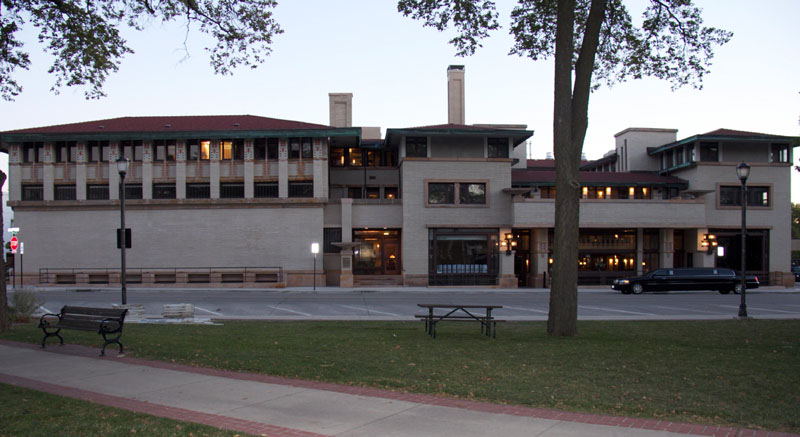 |
Park Inn, Mason City, Iowa |
So, of course, off to Mason City we went ...
Built in 1910 to house a bank to the left and a hotel to the right, the building had been restored at great expense, and in elegant detail, down to the furnishings in the lobby and the twenty-seven guest rooms. (Mine was the entire front of the pagoda-like turret to the far right, beautifully proportioned, windowed, and appointed.) Framed photographs in the rooms showed a couple of Wright-designed private homes in Mason City that were also splendidly envisioned and uniquely executed.
We found a good restaurant nearby, even on a Sunday evening, so our approval of the town was complete. The night music of Mason City (good title) was numerous train horns - the long mournful chord sounding frequently through the night.
Staying with that theme of memorable accommodations (among our usual Walmarts and chain motels), while I was figuring out how best to spend two days off between Chicago and Detroit, I had hoped to visit Isle Royale National Park, in Lake Superior. However, research showed not only how hard it was to get to - four hours by boat from the Upper Michigan side - but the only accommodations on the island closed on September 8, one week too early for my plans.
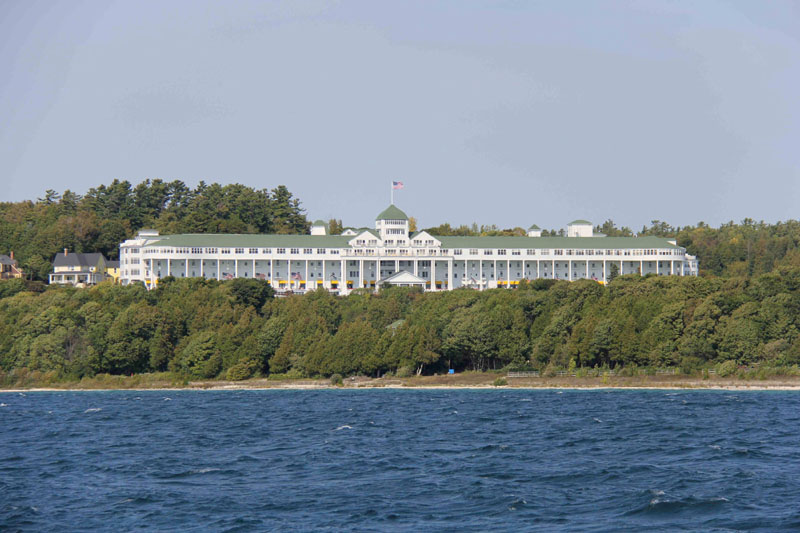 |
Grand Hotel, Mackinac Island, Michigan |
Since childhood I remembered hearing from time to time about an island in upper Lake Huron that had banned automobiles long ago, and everyone traveled by horse-drawn vehicles. Mackinac Island, it was called, near Mackinaw City (both pronounced the same, just French and English spellings of the Native name). By having Dave drive us to Green Bay, Wisconsin, after the Chicago show, Michael and I could get across the Upper Peninsula of Michigan to St. Ignace by mid-afternoon. We parked our bikes in the ferry company's shed, and boarded the passenger ferry for the short ride to the island. We would have two nights and a day there. On the way over, our accommodations came into view ...
At the ferry dock, among other horse-drawn vehicles, we found an elegant carriage in shiny dark red lacquer with "Grand Hotel" gold-leafed on its sides. It was pulled by two dapple-gray draft horses in ornate harnesses. Climbing in knee-to-knee with a few other tourists (once school opens, most travelers seem to be about eighty - which suits me fine, as I am anonymous among them), we were carried up the hill. The hotel's porch is advertised as the longest in the world, 900 feet - almost a football field. Automobiles were outlawed in 1898, and the horse-drawn carriages are not just for tourists - only emergency vehicles and construction machines are allowed.
During that long, easeful day off, Michael and I took a private carriage tour of the island. ("No Michael, it was not romantic!") Our guide Rebecca told us what it was like to live there year-round. The winter population was around 600 people, and when we asked what they did, she said, "We drink a lot of beer."
The island was actually the second designated national park in the United States, in 1875, after Yellowstone, and was looked after by the soldiers from Fort Mackinac. After twenty years the military abandoned their fort, and with no one to take care of the preserve, it reverted to the state of Michigan, which still holds eighty percent of the island as a state park.
Again, such a place surely represents "the better angels of our nature," as I continued to read Steven Pinker's book during that restful day.
Interestingly, as Pinker sets out to show that people are not only dramatically less violent than past generations and cultures, but even measurably smarter, his list of factors - reason, education, democracy - does not include religion. As befits a serious scholar, he is carefully even-handed, and gives credit to the influence of the Quakers in abolishing the slave trade, and to the African-American churches for helping to keep the Civil Rights struggles from becoming violent (though noting that Martin Luther King Jr. was more influenced by secular philosophers and Gandhi than by his Divinity studies). But at the same time he is unable to avoid showing that the Religious Wars of the past millennium were the cruelest and most murderous times in history, and that overall, religion has not been an "improving" force in human behavior.
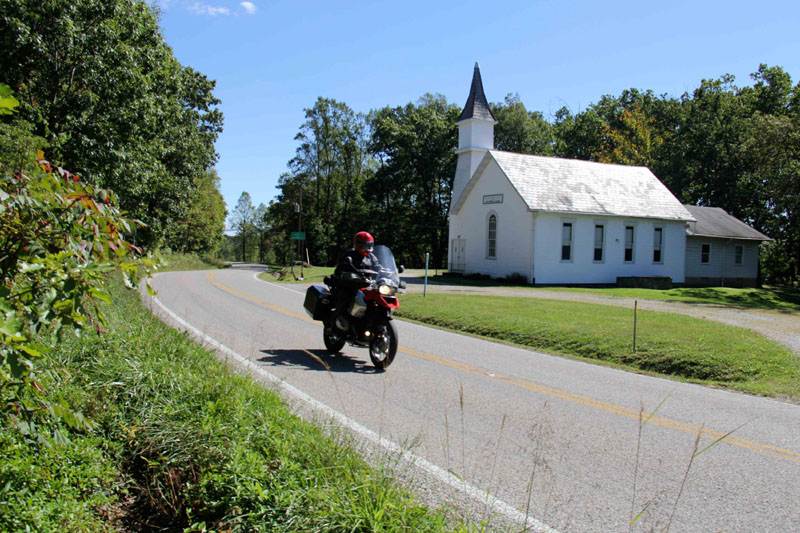
Reason, education, and democracy have been the real faith, hope, and charity in that elevation.
It bothers me a little to have gained a reputation as a "faith-basher." Though I get how some of my lyrics and other writings inspire that tag, in an everyday way I don't feel like I stand against anything that strongly. I feel more like a positive audience for the world I move through. (As Paul Theroux said, "It takes a lot of optimism to be a traveler.")
For me, such reactions always result from direct observation. Or in this case, confrontation.
Two quotes apply. The first I have tried to keep in mind for many years, after watching a foreign correspondent speaking to camera on location in some troubled place. In telling what he had seen, he said something like, "I only report this, I do not comment."
The second is one of the deepest thoughts ever attributed to Ronald Reagan.
"Don't be afraid to see what you see."
I have been thinking about that one for years.
When I am anywhere in my native Canada, or Europe, or in California, or around the East Coast, religion is not a subject I think about very often. Recognizing its controversial nature and not wanting to be vilified for something that doesn't mean much to me, I frequently resolve not to bother writing about the subject again.
Until ... my travels push me south, and force me to confront a shocking fortress, a walled kingdom buttressed by church signs and billboards, all shouting at me, assaulting me, with breathtaking arrogance and ignorance. It can be funny at first, but soon becomes appalling - such a backwards drag on the country, and the world.
As described in Roadshow, it was the American Mid-South with its smack-you-in-the-face-right-to-hell kind of old-time religion that inspired the reactions I wove into that book, then into the lyrics for Snakes and Arrows. The same unavoidable reaction seeped into many of the stories I have written since - based on personal exposure to those benighted regions.
You know what it's like? It's like when I find myself riding in a state with no helmet law. Helmet-wearing is another issue I don't think much about in most places in North America or Europe, where people wear helmets, whether by law or by choice. When I suddenly start seeing bare-headed riders looking all pea-headed (in both senses), it gets my attention, and my thoughts, and begs to be reported.
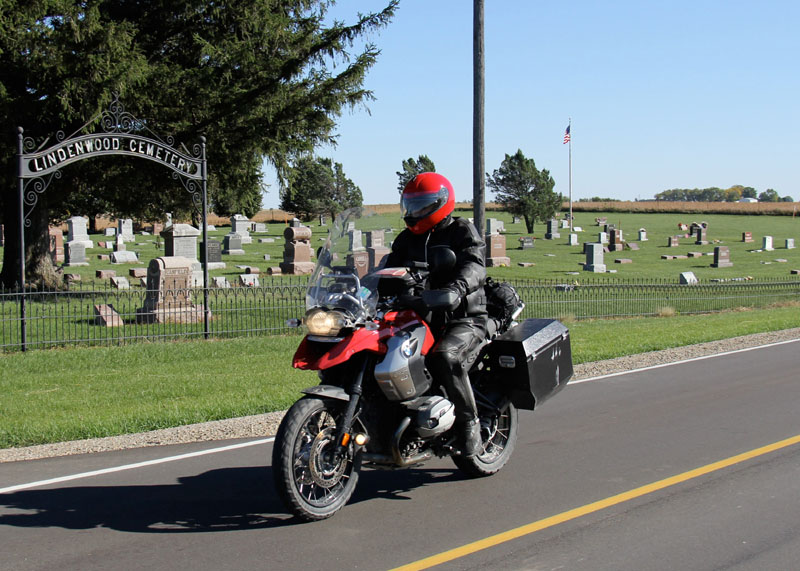 |
Whistlin' Past the Graveyard |
Pinker's researches also show that everyone thinks they are above average - in intelligence, driving ability, and morality. (Psychologists call it the "Lake Wobegon Effect," after Garrison Keillor's fictional Minnesota community "where all the children are above average.") Pinker also points out the even more absurd belief that almost everyone considers themselves to be "lucky." So basically people figure they're too smart to be fooled by anything, and too lucky for anything bad to happen to them.
With protective clothing for motorcyclists, as with religion, there's no point harping on it - you're not going to change anyone's stubborn convictions. But you have to speak out for the young people - you might just plant a seed of sense or rebellion in a young mind.
At the beginning of this tour, the modest churches in New England didn't faze me at all - just decorative centerpieces for the villages. But as we rode into Southern Pennsylvania, then West Virginia and Kentucky and so on, our eyes and brains were assaulted by a constant barrage of scolding church signs and lurid billboards.
"God only wrote one book. Don't U think U should read it ?" (So wrong, on so many levels. Even theologically.) "Serving God is like learning to play golf. Keep your knees bent and your arms extended ." (Seriously?) Or how about riding past a "Christian riding stable," with a sign advertising their mission statement: "Teaching the Lord's truths through horsemanship ." I only report it, I do not comment. In a small Kentucky city, the sheriff's car was one of those retro-mobster Chrysler models blacked-out and armored like dystopian battle-wagons that are so popular with LEOs in small towns and certain state patrols. Apart from the usual insignia, its trunk was decorated with gold-leaf letters reading "In God We Trust," plus the chrome "fish" emblem devout Christians often sport on their vehicles (without considering the unfortunate metaphor - like the sheep one they also favor), and also a painted scripture reference, "Psalm 118." (A particularly rapturous hymn of praise, it also contains the scary line, "All nations surrounded me, but in the name of the Lord I will destroy them.") Just seeing what I see, and sharing it. You gotta testify. Because ... I love these roads and little places I ramble through, and believe these people are good at heart - just brainwashed from childhood. I dislike the elitist coastal notion of Middle America as "flyover country" - for me it is "ride-through country." I would rather fly over New York City and Los Angeles, and ride through the rest!
In Deer Hunting With Jesus, the author Joe Bageant writes about growing up in Northwestern Virginia, near the West Virginia line, then moving out into the "wider world." In an affectionate lament, he shakes his head over the fates of his former neighbors, seeing how they defiantly stand in their own way, and stubbornly vote against their own best interests. If you care about the well-being of your fellow humans, such a plight is bound to bother you. Steven Pinker convincingly illustrates how Southerners have retained from their Scots-Irish ancestors an outdated "honor code" - a thin-skinned pugnacity that leads to a culture of violence. (He also shows that the distinction is not racial - Yankees of all races are less violent). I only repeat this, but it does seem as though that "oh yeah?" response is reflected even in the belligerence of their faith. The Better Angels of Our Nature also cites clinical tests showing that people everywhere will pretend to believe what those around them profess, as a simple human response to "fitting in." We all know that people who are pretending something get very angry if mocked - because they are embarrassed, a tiny step from resentful rage - and as for guilty doubters of a faith, they may well be the fiercest voices in the choir. One giant billboard a hundred feet above the road asserted, "HELL IS REAL." At a stoplight, Michael said, in a world-weary tone, "Oh, I know. I'm in it." He didn't mean the place - he meant my company. (Bitter, hateful man.) But let us ride away from these unrewarding subjects. ("Bye Michael!") I would merely point out that such fanatics hold themselves back, and the rest of us, too. Radical Islam is a worrisome barrier to the world's upward motion, but there are others eager to impede reason ("Lean not upon your own understanding"), education (ancient myths taught as "science"), and democracy (medieval beliefs become national policy). Such throwbacks only impede the progress of our better angels. The theme of great beauty hiding terrible ugliness brings us, at last, all the way back to Western North Dakota, and Theodore Roosevelt National Park. Winding toward that segue, we also carry along some other themes, like a traveler's natural wonder about what is really best for the world around him. This one's a tough nut - people will have to judge for themselves. Clues appeared as Michael and I rode west from Bismarck, beginning our day off with something over a hundred miles on Interstate 94. (A necessary sacrifice to get us to Theodore Roosevelt National Park, where I could collect a new passport stamp - all meaningless to Michael - and get us close enough to the next show in Winnipeg to make it on the show day.) On that bright, chilly morning, we passed many semis carrying unusual loads - clearly marked modules of oil wells, for example, portable construction offices, and long, wide structures of unidentifiable hardware. It was when we left the park that things became bad. I had looped through Eastern North Dakota on a previous tour, and thought I knew what the state was like. Wheat and ranchland dotted with bird-friendly wetlands, occasional small towns with water towers and cottonwoods, and many abandoned farmhouses (describing those at the time as the "state symbol"). This time, highlighting my route from the national park up toward Minot for the night had seemed easy - long straight backroads north through the Fort Berthold Indian Reservation (another fascinating history), a couple of small dots and town names among the likely wheat and ranchland, then over the Little Missouri River and a casual northeast zigzag. The reality was harshly different. Backtracking a few miles east on the interstate, we turned north on little Highway 85, and were immediately surrounded by trucks. Looming ahead of us, and thundering toward us, were road construction vehicles, side-loading semi dump trucks, and dozens of tankers - not the shiny mirror ones you see on the interstate, but crude, trellis frames around muddy gray iron cylinders. I had routed us through Killdeer, thinking it looked big enough on the map that it should have a gas station, and because it is named after a bird I like (a grasslands plover that fakes a broken wing and distress call - its namesake "kill-deer, kill-deer" - to lead predators away from its nest). At its crossroads we approached a scene of raw devastation on a huge scale, a vast construction site of mud and gravel where the intersection was being enlarged from two lanes in each direction to what looked like it would be six. We had to weave through the muddy gravel and semis to the gas station, and through what used to be a typical prairie town. As we traveled north, the construction sites increased, and we were shunted on makeshift detours where miles of road were torn up and diverted onto dirt and gravel lanes. If it had been raining, we would have been in big trouble on a surface like that (as I knew from experience on such "roads" in the Arctic when it rained). In one case, a long stretch of highway was simply barricaded off while they blasted and widened it, sending us about a hundred miles out of our way. Anywhere else in America, that would never stand. (My paper map still showed that road as a dotted-line "scenic route," so I knew whatever was going on around there, it had changed fast.) Encampments at the roadside were scattered with hundreds of small travel-trailers, dormitories for the workers and drivers, and water was being pumped out of roadside sloughs to fill the tankers that sprinkle the detours to keep the dust down. Ranchers and farmers posted homemade signs offering patches of open land for truck parking. I couldn't figure out what was going on around us, but I thought, "Whatever it is, it's awful." All of that construction and traffic slowed us down a lot, as did the long detour, and it was late in the day before we reached Minot. We almost never have trouble finding rooms in whatever little town we roll into, and I had explored Minot's meager offerings before, and knew the Holiday Inn was about the best to be had. But as we rode past the fairgrounds and saw parking lots full of trucks and RVs, and the hotel parking lot jammed with pickups, I began to worry. Sure enough, it was state fair time, and not a room to be had in the whole town. Remarkably, there was no grumbling - we just faced our fates, fueled up and kept riding, another hour east to Rugby, North Dakota. Rugby bills itself as "The Geographical Center of North America," and on that theme, we had The Hub motel (big metal sign showing a map of North America with a starred dot in the middle) and an attached restaurant. After an eleven-hour day and almost 500 miles, we would not begrudge its basic comforts. Nor would there be any complaining the next morning, when we rose early, scraped the frost off our saddles (it was exactly freezing - 0° C.), and rode another 300 miles to Winnipeg. Michael was really having fun now, and said, "Why is it that when I'm traveling with you, I'm always either sweltering or shivering?" I said, "Because you always have the wrong clothes!" But that evening in Rugby, after a simple dinner at the Hub of North America (once again, with a wine list of soda pops), I leafed through the newsletter we had been given at the national park. There I found the answer to "awful," under the headline, "What's going on around here?!" That is another very even-handed appraisal, it seems to me, for a national park publication. And the question they raise about balancing development and protection is "difficult" indeed. This oil boom in Western North Dakota has only been underway for about three years, and the pace of it is frenetic, rapacious. The only such careless extraction of resources regardless of consequences I have witnessed are in Northern Canada, China, and West Africa. The only such devastation disguised as road construction I have witnessed is in the Arctic, and in Argentina. These are not good examples. Now, having learned a fair amount about what's going on "Deep in West Dakota," especially first-hand accounts from people living and working there, I am fairly horrified - but trying very hard not to go off into an environmental rant. In the spirit of "Don't be afraid to see what you see," though, and wanting to share it, for the above article to say that extracting fossil fuels by hydraulic fracturing, or fracking, is "controversial" is wildly diplomatic. (And that must be a unique oxymoron.) Groundwater is poisoned, often permanently, farmland is destroyed, often for decades, by leaks of the poisonous "brine" used in the process (and, unbelievably, the oil companies alone are responsible for reporting their own spills, with almost no oversight). Surface water from the prairie wetlands that serve as migration oases for millions of birds is pumped away to dampen the dusty roads. Tens of thousands of workers - not to mention tens of thousands of semis - have a far-reaching effect on the environment. Just for one small example, those encampments of house trailers - where does their sewage go? So it's a big mess. My first response was accurate, "Whatever it is, it's awful." And yet ... in a few brief years North Dakota has shot from being a state in population decline, in a time of economic recession, to having the lowest unemployment rate in the United States, workers flocking in from everywhere, and a billion-dollar state surplus. All of a sudden, North Dakota is the second-largest oil producer in the United States, after Texas. This is indeed a boom. One can easily parrot the justification - "To reduce our dependence on foreign oil," and if we add another hot political keyword, "Jobs," the sum of that equation is "Votes." It adds up to the same equation that strips the mountaintops of West Virginia for coal (I saw the same thing happening on a remote backroad in Alberta, just west of Edmonton), and - indeed - that keeps the coal industry going at all. But I've ranted about that before. This is about what is happening two miles deep in West Dakota. And the thing is, in all of these places, I want people to have jobs. But not these dirty, nasty jobs, and a life that answers the dark premonitions of Thomas Hobbes (a frequent reference in The Better Angels of Our Nature). "No arts; no letters; no society; and which is worst of all, continual fear, and danger of violent death: and the life of man, solitary, poor, nasty, brutish and short." That surely describes how life can be in coal towns and oilfields, and I don't wish an existence like that for anyone. Even if it will "reduce our dependence on foreign oil," and produce jobs. Or votes. A further metaphor about "roads no one travels unless they live on them" says something about integrity. The roads I travel are the ones I live on - in every sense. In the largest abstraction, the work I do and the way I live has to reflect that direct engagement with the world around me. Not everyone lives on the roads they travel - especially, say, politicians and financiers. They talk the necessary talk to get the votes or the deals, and console themselves that they are doing the right thing, and the lies are just a means. So they aren't riding that road - but they don't care. The rest of us should. Perhaps the saddest roads in America are the ones that people used to live on, but don't anymore. Some stretches of Old 66, little towns in the Midwest whose Main Street stores are boarded up, with maybe a few optimistically repurposed as antique shops or local museums (in a formulation I have expressed before, the closed shops, restaurants, and gas stations represent the death of someone's dream), and - aptly - the abandoned farmhouses of North Dakota. Places where people don't live anymore. For myself, I plan to keep exploring these roads and seeing what I see. And I plan to keep making Michael's life as much of a living hell as I can. Because he knows what the billboard preaches: "HELL IS REAL." Oh yes. My journal notes from the first few days of this tour mention the idea of the "rolling stage." In our professional life, arenas sometimes have a portable stage on wheels, and at the beginning of the day it is positioned toward the center of the "rink." Thus the overhead work on P.A., lights, and video screens can go on while our band crew assembles the instruments on the rolling stage, away from that aerial activity. Once the overhead stuff is ready, the stage is pushed into place, at the end of the rink under the lights, by a team of stagehands. (Drum tech Gump very much appreciates those stages, as he has more time to put up the kit than if our band crew doesn't get onstage until the overhead stuff is done.) A rolling stage also stands as a decent metaphor for a concert tour, and, stretched a little farther, for what Michael and I (and sometimes Brutus) do. From the interior vantage point, onstage or on the bike, I am performing - "operating the machine." Mind and body are fully engaged in the mechanics and art of executing, adapting, and being as smooth and accurate as I can. But at the same time, I am observing the "rolling stage" in front of me - whether a pageant of scenery or an appreciative audience. Just before band rehearsals I wrote a piece for Drum Workshop's Edge magazine about my long preparations, physically and musically, and each of us brought that dedication to the rehearsal hall from the beginning. Over the course of many months, we built up the most musically adventurous and visually "active" show we have ever presented. Deciding to do two different shows on alternate nights, with a number of songs changing, and even a few "one-off" songs for special occasions, has been uplifting for us. Perhaps most uplifting of all has been adding "guest musicians" to our show for the first time in our lengthy career. Having the Clockwork Angels String Ensemble join us makes the second set really special. The eight string players were chosen by arranger David Campbell, who wrote the scores for the Clockwork Angels album as well as for a number of older songs in the set. The string arrangement for "YYZ" was an afterthought. That instrumental was originally planned to be played as a trio, after we said "A Farewell to Strings." But when we noticed that it began with Geddy playing string samples on his foot pedals, after the real thing, it just seemed wrong. David wrote an arrangement for the strings to accompany us, and that song came to represent the climax of the show, I think - at least on our side of the barricade. I am not able to watch the string players perform, as they are on a riser behind me, and I can't listen to them much. (Needing to lay down a strong foundation for all those players, as in a big band, I have to concentrate on the accuracy and smoothness of my own part.) But I can certainly feel the energy they bring to their performance, add to our show, and contribute to the interplay my more mobile bandmates are able to have with them. As my young (well, mid-thirties) nephew Sean said about an early show, "Those string players sound amazing - and they rock!" On both my rolling stages, it is good to feel that we are exploring new territory, with unflinching determination, youthful energy, and great satisfaction in doing it. And even with this story's prodigious length, I am skipping so many wonderful images and tempting stories from our 7,000 miles of motorcycling - the Lafayette Hotel in Marietta, Ohio; riding the Ozarks with Tom Marinelli, or the backroads of Saskatchewan and Alberta with Brutus - and how each of the twelve shows kept getting better and more energized as we went. But at this late hour, I must sacrifice the perfect for the good, because soon enough my stages will be rolling again. There will be more stories and more photos, as I lead Michael on the never-ending roller-coaster ride to hell. He knows, and Brutus knows, and the Clockwork Angels String Ensemble is beginning to learn - everybody behind me is going to burn. Oh yes ...
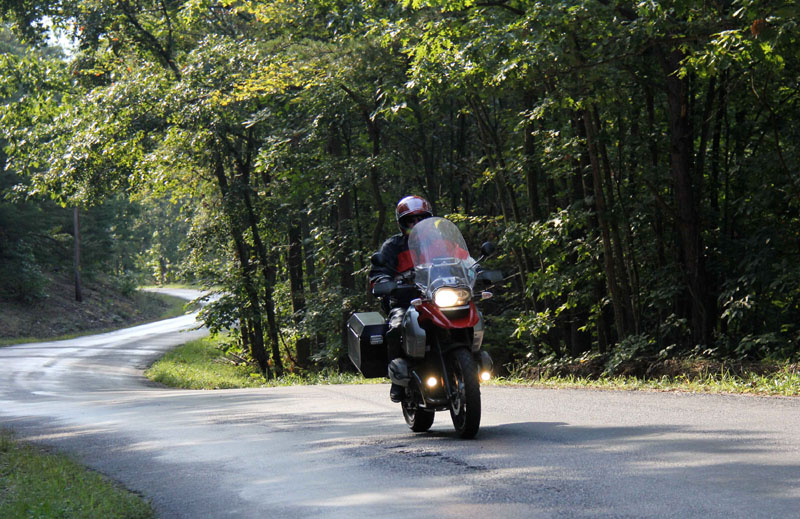
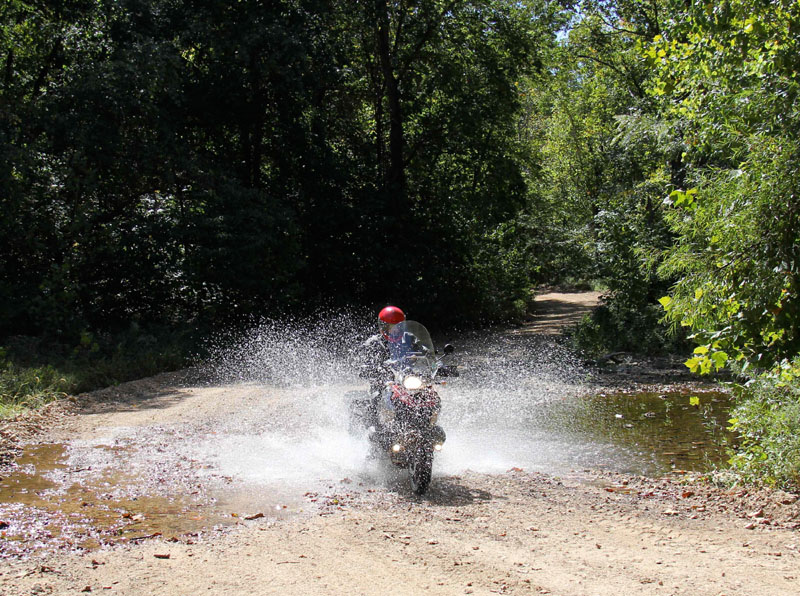
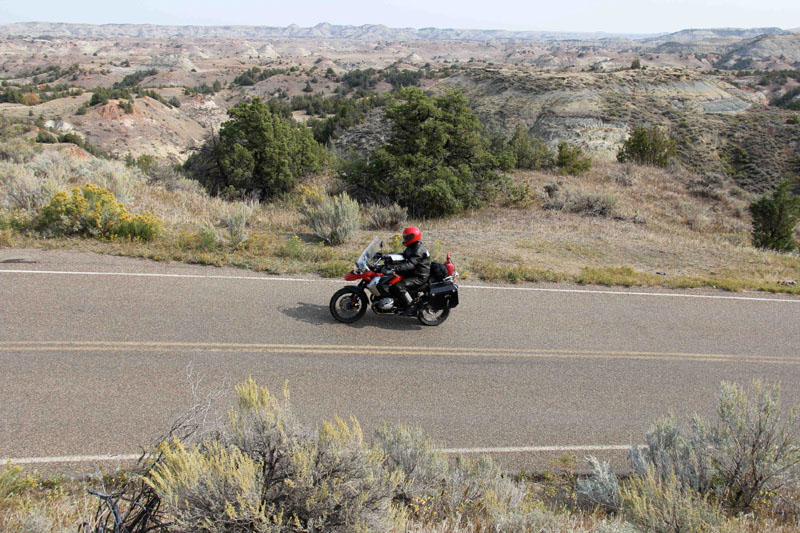
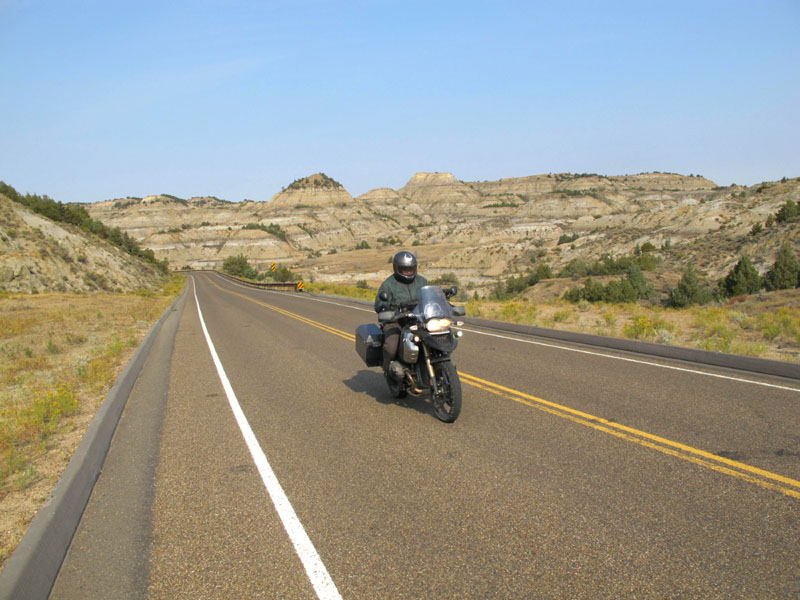
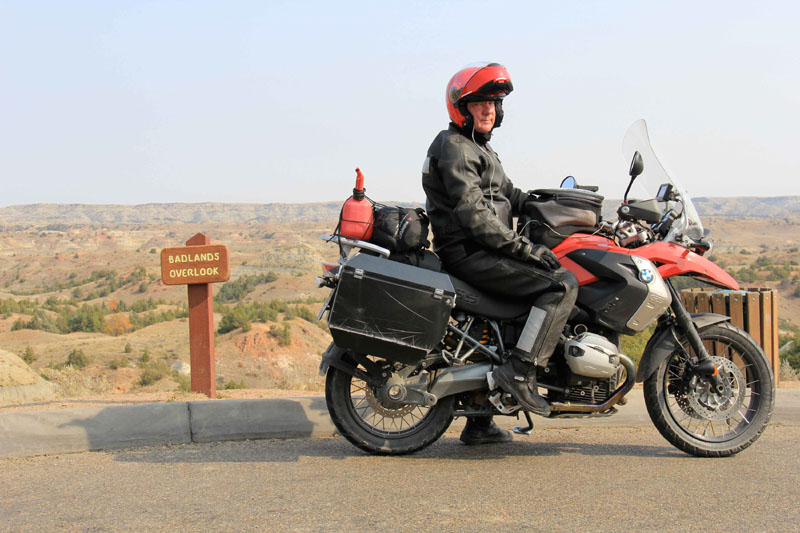
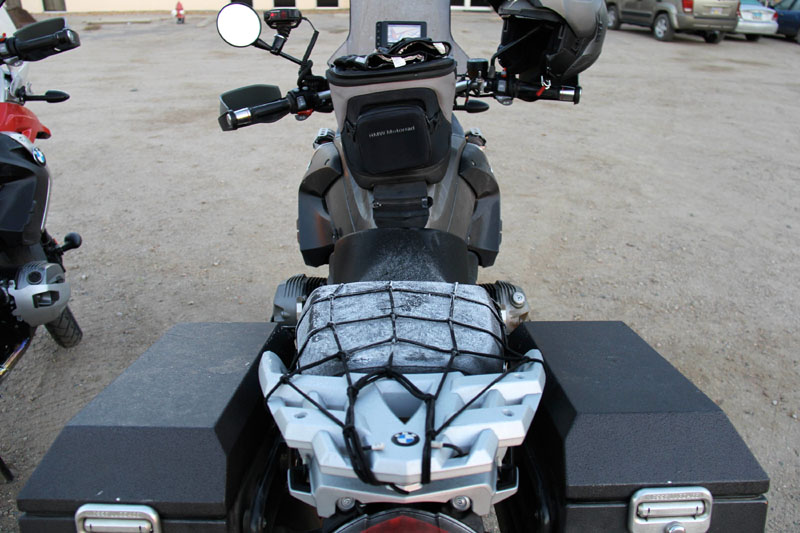
"Surprised by the amount of truck traffic in the area? Unable to get a hotel reservation? Can't find the sleepy cowboy towns you remember? The reason for the incredible changes this area is experiencing lies two miles below the surface of western North Dakota - a formation called the Bakken. The Bakken formation is a rock layer rich with oil reserves. Until recently, the oil was not extractable. A new and controversial technique - hydraulic fracturing or "fracking" - has allowed oil companies to more than quadruple their daily oil production in the last five years. The huge influx of activity has brought tens of thousands of new jobs to the area. In a national economy where jobs are scarce, North Dakota has become the "land of opportunity" for many.
"All three North Dakota National Parks are experiencing serious issues due to the oil boom. New wells are going in every month; many can be seen from inside park boundaries. Each new well means another drill rig, well pad, pumpjack, debris pit, flare pit, storage tanks, and access road on the landscape. Each new well requires 2,000 "trucking events" to complete its setup and to begin pumping oil. Noise and dust from heavy truck traffic and pumping equipment is constant. Numerous flares can be seen in the formerly dark night sky as excess natural gas is burned off. Socioeconomic impacts are altering local communities. A multifaceted topic to be sure, the oil boom begs a difficult question: how can we develop our resources while still protecting our parks and communities?"
